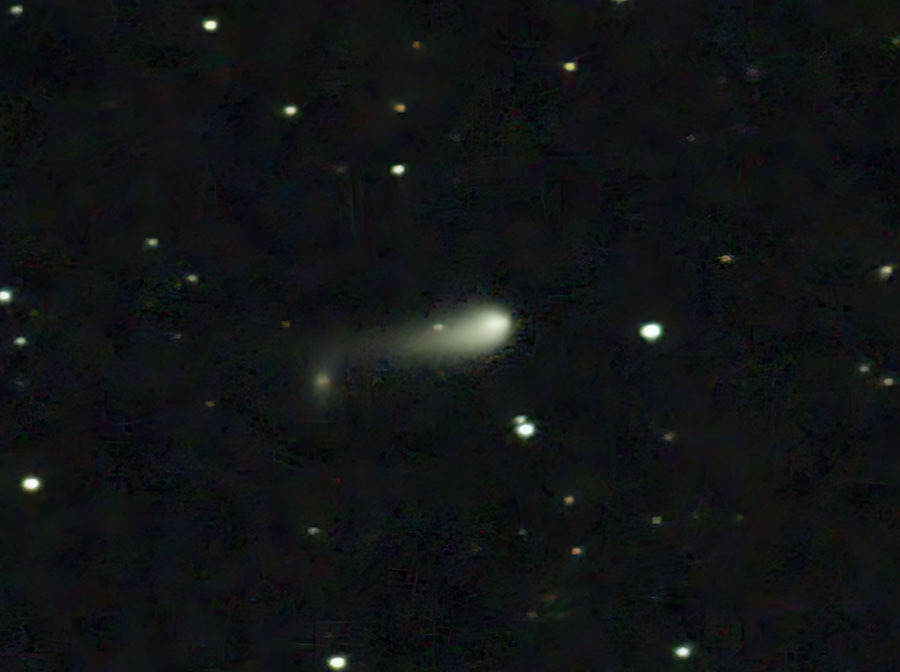On April 25th I pointed my 15-inch Dob toward the much-anticipated Comet Tsuchinshan-ATLAS (C/2023 A3) and was thrilled to see how much brighter it had become since mid-winter — up to magnitude 9.7. Even at low magnification (67×) the small but strongly condensed coma was immediately apparent. I could even trace a 2′ tail curving to the east-southeast. Increasing the magnification and using averted vision I detected a slight twist in the tail that gave the object a comma-like appearance clearly depicted in images.

MegaStar, courtesy of Emil Bonanno
I reobserved it on May 4th, and although the coma's overall brightness had diminished to 10.0 the tail had accordioned to 3′. My initial observation of a brighter coma in April had much to do with the comet's orientation relative to Earth. Only a week before, on April 18th, the object lay nearly opposite the Sun in Earth's sky like the Moon does at full phase. With the Sun at our backs, cometary dust particles hide their shadows, so we only see their bright, sunlit surfaces, leading to a temporary brightness surge called the opposition effect. The same alignment, with a helping hand from coherent backscattering, bumps up the full Moon's brightness, intensifies Saturn's ringsat opposition, and gives rise to the gegenschein.

Bob King
Qicheng Zhang, a postdoctoral fellow working on small-body astronomy at Lowell Observatory (Arizona), noted that the viewing geometry in mid- to late April also meant that the tail was tucked behind the coma which further boosted the comet's apparent brightness. In short, the spike in light has nothing to do with intrinsic activity. Comet Tsuchinshan-ATLAS's magnitude has since leveled out. Barring future outbursts — never a guarantee! — it should gradually brighten. Observers with access to dark skies will be able to track down C/2023 A3 in a 6-inch telescope as it glides northwest across Virgo this month.

Gideon van Buitenen
We expect a slow and steady rise from magnitude 10 in early May to magnitude 8.5 by early July before observers at mid-northern latitudes lose sight of it in the solar glare. Equatorial and Southern Hemisphere skywatchers will be able to hold on to the comet until mid-August when it could reach magnitude 6.5.

Gianluca Masi / Virtual Telescope Project 2.0
When it returns to view in mid- to late September for both hemispheres, C/2023 A3 will hang just a few degrees above the eastern horizon in a twilight-soaked morning sky and shine around 1st magnitude or brighter. When October opens the comet is already dashing back in the Sun's direction and briefly disappears from view before it slingshots into the evening sky at mid-month.
If the object releases a lot of dust as it rounds the Sun, forward scattering (discussed below) could briefly raise its magnitude into negative territory, suggesting the possibility of seeing this rare visitor in the daytime sky with a small telescope.

Bob King
REASONS FOR OPTIMISM
Mid- to late October will likely be the most fortuitous time for observation. As C/2023 A3 swiftly distances itself from the Sun it may exhibit both a prominent dust tail and anti-tail provided it survives perihelion and releases oodles of dust during its solar passage. Here's why:
- C/2023 A3 will enter the evening sky at a high phase angle around 145°. Forward scattering of sunlight from the dust could greatly enhance the brightness of the tail.
- Earth passes through the comet's orbital plane on October 14th. Dust released prior to this time will be stacked along our line of sight and could greatly amplify the tail's surface brightness, according to Zhang.
- During orbital plane crossing, not only will the material be "superimposed on top of the normal tail," said Zhang, "it should also extend far in the opposite direction" to form a prominent anti-tail, similar to that observed in Comet Arend-Roland (C/1956 R1) in 1956-7.

Public domain
Recent observations reveal yellow and pink hues in C/2023 A3's developing coma suggesting the presence of dust. That's a good sign. The wild card is that the comet is dynamically new, a fresh arrival from the Oort Cloud making its first trip around the Sun. Many of its kind are infamous for crumbling apart on approach to perihelion like what happened to Comet ISON (C/2012 S1) in late November 2013. Still, I remain optimistic. Let's see where Comet Tsuchinshan-ATLAS will take us.
Quelle: Sky&Telescope

